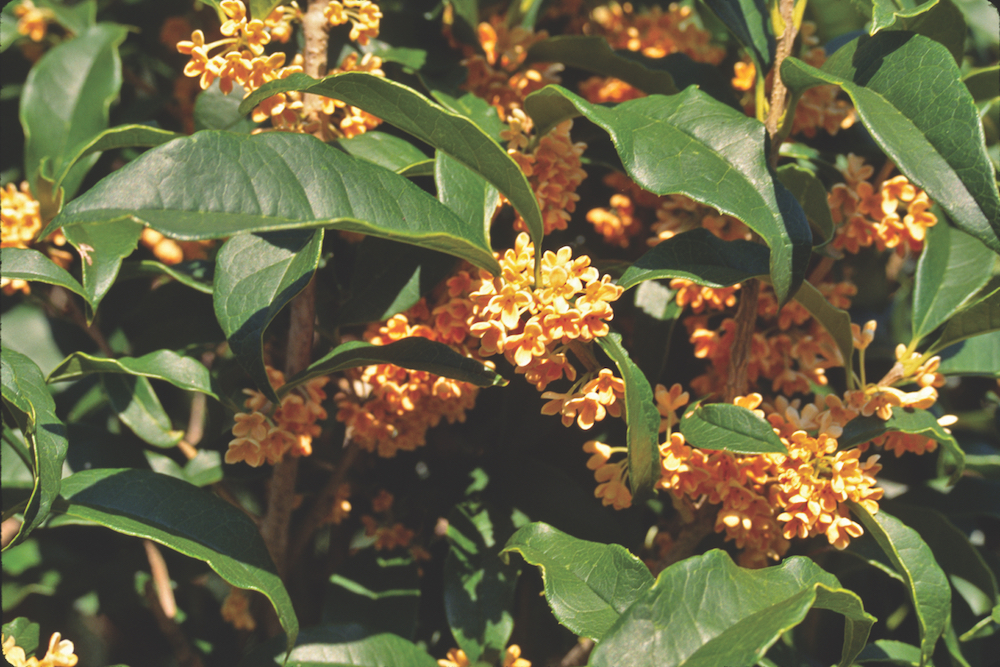We often repeat Alice Callaway’s quote about gardening during weather extremes. She would say to visitors, “I would give this garden to anybody that wanted it in January or August, but I’d want it back the rest of the year.” Needless to say, by summer’s end autumn beckons the gardener in a climate such as ours, where “August” often seems to arrive in June and set up camp until September.
Mrs. Callaway loved autumn here at Hills & Dales and often mentioned the cool, crisp mornings followed by still-warm days, beautiful sunlight and shadows, and of course the change of seasons, heralded by the plants on the estate. She obviously wanted this to be a four season garden, for she carefully chose plants for each one. This article is dedicated to a few of her favorites from the genus Osmanthus that scent the fall garden.
We’ll begin with tea olive, although Mrs. Callaway can’t be given credit for planting it here first. We believe that Sarah Ferrell planted it originally within the terraces of Ferrell Gardens, and it was also grown and appreciated by Ida Cason Callaway. Its botanical name is Osmanthus fragrans and it may also be known to some as sweet olive. The common names for it are very telling as “sweet” refers to its wonderful fragrance, “tea” to the Asian practice of flavoring tea with its flowers, and “olive” because it is a member of the olive family. Tea olive is native to China, where it is highly revered. There are Chinese specimens that are over 1,000 years old, which makes its 150 year history in U.S. gardens seem paltry. Many readers will be familiar with this beloved garden favorite of the Deep South, but for the uninitiated it is, in a word, divine. In the garden we are fortunate to have two, thirty foot specimens whose small creamy blossoms perfume the air in late winter, spring, and again, most prolifically for us in the fall. Tea olive is not generally considered a rapid grower but will grow 20-30 feet high and about half that in width if allowed to reach full size. It is a bit tender and benefits from a protected location when grown north of zone 9.
Most tea olive shrubs bloom with white, cream, or pale yellow flowers. However, Alice added a more uncommon type of O. fragrans to the garden, the orange flowering Forma aurantiacus. Alice’s gardening friends and relatives no doubt remember her penchant for the rare and unusual, and orange tea olive fits the bill as it is seldom seen in gardens. It only blooms in the fall, but the small orange blossoms are pretty and their fragrance is subtly different from those of regular tea olive. Both are most often described as “fruity floral” with some catching whiffs of apricot, while others smell jasmine and citrus.
A more cold hardy osmanthus that Alice cultivated is Fortune’s osmanthus, O. X fortunei, which is a hybrid of O. fragrans and the spiny leaf O. heterophyllus. Scottish botanist and plant explorer, Robert Fortune, introduced it into cultivation in England in the 1850’s, and it was named in his honor. The juvenile foliage of Fortune’s osmanthus has spines and is often mistaken for holly, but no holly scents the garden like this. The aroma of its white blooms is headier than varieties of sweet olive but it is wonderful just the same. It’s an excellent choice for an evergreen hedge or screen, providing a literal wall of fragrance in October. As mentioned earlier, this one can tolerate colder temperatures than O. fragrans and is reliably hardy throughout zone 7, thus making it a better landscape choice for the Upper South.
All of the osmanthus mentioned here like full sun to partial shade and are not fussy. They are seldom bothered by insects or disease and are considerably drought tolerant once they are well established. Their foliage is quite handsome and all of these attributes alone would qualify them as great candidates for the southern garden. Ah… but factor in the delicious sweet scent of these plants in autumn and you now have a garden legend.
